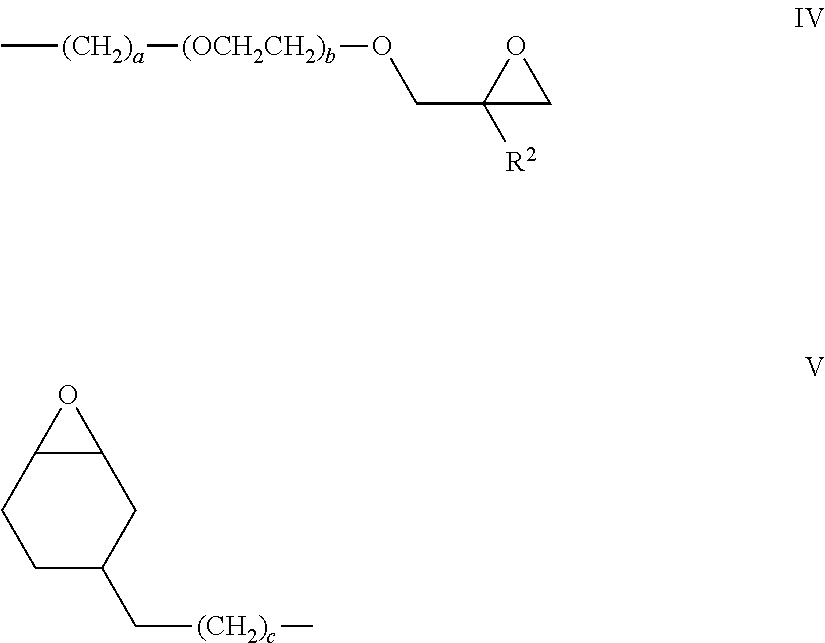Antistatic Sol/Gel Compositions and Optical Articles Coated Therewith
an anti-static, sol/gel technology, applied in the direction of electrically-conductive paints, polyether coatings, other chemical processes, etc., can solve the problems of easy damage to optical articles, essentially composed of insulating materials, and prone to static electricity charge of optical articles,
- Summary
- Abstract
- Description
- Claims
- Application Information
AI Technical Summary
Benefits of technology
Problems solved by technology
Method used
Image
Examples
example 1
[0173]The antistatic composition No 1 is deposited on both faces of an ORMA® lens by dip coating and cured at 75° C. during 30 minutes to form a layer of 1 to 2 μm thickness.
[0174]Then an abrasion-resistant layer of 2.5 to 3.5 μm is formed by dip coating on both sides of the lens on top of the antistatic layer, pre-cured at 75° C. for 12 minutes and cured at 105° for 3 hours.
[0175]Properties of the resulting coated lens are given in table III below.
TABLE IIITestingMethod and conditionValueCharge decay time (ms)JCI, humidity 30% at 25° C.100~200JCI, humidity 30% at 25° C.100~200TransmittanceCary-50 UV-Visible>92.0%Light absorptionSMR and Cary-50 UV-Visible HazeHaze-GuardAdhesion of anti-static hard coatDry cross hatch0Abrasion resistanceISTM Bayer test (Bayer Alumina)>5UV agingSun test 200 hrs (Dry cross hatch)0Shock resistanceFDA impact resistance testpass
examples 2 to 4
[0176]ORMA® lens substrates were coated as follows:
[0177]The lenses were coated by dip coating successively with an antistatic composition no1 and an abrasion-resistant coating as defined above. The only difference in examples 2 to 4 is the thickness of the antistatic coating.
[0178]The resulting products were submitted to the FDA impact test, modified by the fact that the height of dropping was increased up to the breaking of the lens. The results are given in table IV:
TABLE IVDrop Ball testThickness of antistaticAverage energy (mJ) Example n°coating (μm)at break (30 samples)21.170131.377541.9877
[0179]The obtained values of energies at break are far higher than the FDA value of 200 mJ that a lens has to pass according to the FDA drop ball test.
examples 5 to 9
[0182]ORMA® lens substrates were first coated with a primer layer (W234™ latex from Baxenden) by dip or spin coating and then cured at 75° C. for 15 min. Then, the antistatic abrasion resistant coating was deposited onto said primer by dip or spin coating, cured at 75° C. for 30 min and post-cured at 105° C. for 2 hours. A layer of about 2˜3 μm of thickness was obtained.
[0183]Properties of the resulting coated lenses are given in table V below.
TABLE VChargedecayAdhesion oftime (ms)anti-staticJCI,Trans-hard coatAbrasionhumiditymittanceHazeDryWetresistance50% atCary-50 UV-Haze-crosscrossISTM-Example25° C.VisibleGuardhatchhatchBayer5100~20092.8004.086 50~12092.8002.90792.8002.46892.8002.15992.8001.95
PUM
| Property | Measurement | Unit |
|---|---|---|
| Percent by mass | aaaaa | aaaaa |
| Percent by mass | aaaaa | aaaaa |
| Percent by mass | aaaaa | aaaaa |
Abstract
Description
Claims
Application Information
 Login to View More
Login to View More - R&D
- Intellectual Property
- Life Sciences
- Materials
- Tech Scout
- Unparalleled Data Quality
- Higher Quality Content
- 60% Fewer Hallucinations
Browse by: Latest US Patents, China's latest patents, Technical Efficacy Thesaurus, Application Domain, Technology Topic, Popular Technical Reports.
© 2025 PatSnap. All rights reserved.Legal|Privacy policy|Modern Slavery Act Transparency Statement|Sitemap|About US| Contact US: help@patsnap.com


